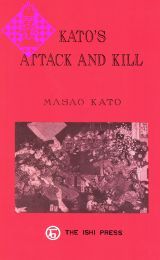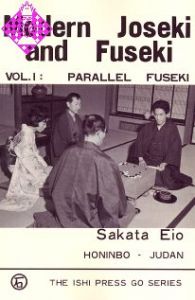Artikelnummer
LGCHIT3-3PMOS
Autor
The 3-3 Point Modern Opening Strategy
G44
214 Seiten, kartoniert, Ishi Press, 2. Auflage 2015
Opening theory in go has a long history and has undergone many changes. In the 17th through 19th centuries, the first move in the corner was usually played on the 3-4 point, or occasionally the 5-3 or the 5-4 points. The star point was almost never played. Then in the mid-1930's, the 'New Fuseki' became the vogue. The star point became a key feature and emphasis was placed on central influence.
In present-day opening theory, the star point still carries great weight, since it occupies the corner in one move, has powerful influence along the sides, and permits a much faster development than the 3-4 point. Its weakness lies at the 3-3 point, from which the corner territory can easily be destroyed. However, more and more openings are being played today which emphasize tight territorial control. Here again the 3-3 point is crucial, whether played to secure the corner territory with one move, or to destroy the opponent's corner territory.
In these openings many questions arise about joseki in relation to the surrounding positions. In other words, joseki cannot be confined to just one corner or to one side; the whole board must be taken into account This book analyses the role of the 3-3 point in opening strategy and features examples taken from about 100 of Cho Chikun's games.
The opening is the most enjoyable part of the game to study. It is also the most intuitive part of the game, and its concepts are the easiest to grasp. Any player who knows the rules should make effortless progress by reading this book.
In present-day opening theory, the star point still carries great weight, since it occupies the corner in one move, has powerful influence along the sides, and permits a much faster development than the 3-4 point. Its weakness lies at the 3-3 point, from which the corner territory can easily be destroyed. However, more and more openings are being played today which emphasize tight territorial control. Here again the 3-3 point is crucial, whether played to secure the corner territory with one move, or to destroy the opponent's corner territory.
In these openings many questions arise about joseki in relation to the surrounding positions. In other words, joseki cannot be confined to just one corner or to one side; the whole board must be taken into account This book analyses the role of the 3-3 point in opening strategy and features examples taken from about 100 of Cho Chikun's games.
The opening is the most enjoyable part of the game to study. It is also the most intuitive part of the game, and its concepts are the easiest to grasp. Any player who knows the rules should make effortless progress by reading this book.
Opening theory in go has a long history and has undergone many changes. In the 17th through 19th centuries, the first move in the corner was usually played on the 3-4 point, or occasionally the 5-3 or the 5-4 points. The star point was almost never played. Then in the mid-1930's, the 'New Fuseki' became the vogue. The star point became a key feature and emphasis was placed on central influence.
In present-day opening theory, the star point still carries great weight, since it occupies the corner in one move, has powerful influence along the sides, and permits a much faster development than the 3-4 point. Its weakness lies at the 3-3 point, from which the corner territory can easily be destroyed. However, more and more openings are being played today which emphasize tight territorial control. Here again the 3-3 point is crucial, whether played to secure the corner territory with one move, or to destroy the opponent's corner territory.
In these openings many questions arise about joseki in relation to the surrounding positions. In other words, joseki cannot be confined to just one corner or to one side; the whole board must be taken into account This book analyses the role of the 3-3 point in opening strategy and features examples taken from about 100 of Cho Chikun's games.
The opening is the most enjoyable part of the game to study. It is also the most intuitive part of the game, and its concepts are the easiest to grasp. Any player who knows the rules should make effortless progress by reading this book.
In present-day opening theory, the star point still carries great weight, since it occupies the corner in one move, has powerful influence along the sides, and permits a much faster development than the 3-4 point. Its weakness lies at the 3-3 point, from which the corner territory can easily be destroyed. However, more and more openings are being played today which emphasize tight territorial control. Here again the 3-3 point is crucial, whether played to secure the corner territory with one move, or to destroy the opponent's corner territory.
In these openings many questions arise about joseki in relation to the surrounding positions. In other words, joseki cannot be confined to just one corner or to one side; the whole board must be taken into account This book analyses the role of the 3-3 point in opening strategy and features examples taken from about 100 of Cho Chikun's games.
The opening is the most enjoyable part of the game to study. It is also the most intuitive part of the game, and its concepts are the easiest to grasp. Any player who knows the rules should make effortless progress by reading this book.
| EAN | 9784871870443 |
|---|---|
| Gewicht | 228 g |
| Hersteller | Ishi Press |
| Breite | 94 mm |
| Höhe | 13,5 cm |
| Medium | Buch |
| Erscheinungsjahr | 2015 |
| Autor | Cho Chikun |
| Sprache | Englisch |
| Auflage | 2 |
| ISBN-10 | 4871870448 |
| ISBN-13 | 978-4871870443 |
| Seiten | 214 |
| Einband | kartoniert |
v Foreword
vi Glossary
001 Introduction: Around the 3-3 Point
001 Star Point, 3-4 Point, and 3-3 Point
007 3-3 Point Joseki
009 3-3 Point Fuseki
013 Chapter 1: The 3-3 Point with the Stair Point and the 3-4 Point
013 3-3 Point and Star Point
066 3-3 Point and 3-4 Point
080 Chapter 2: 3-3 Point Joseki
080 The Shoulder Hit
099 Approach Moves
127 Chapter 3: 3-3 Point Fuseki
127 Black 3-3 Point - Diagonal Formation
142 Black 3-3 Point - Parallel Formation
148 3-3 Point and 3-4 Point - Parallel Formation
156 3-3 Point and Star Point - Diagonal Formation
160 Sanren-Sei and White 3-3 Point
168 Chinese Fuseki and White 3-3 Point
188 Chapter 4: Problems
vi Glossary
001 Introduction: Around the 3-3 Point
001 Star Point, 3-4 Point, and 3-3 Point
007 3-3 Point Joseki
009 3-3 Point Fuseki
013 Chapter 1: The 3-3 Point with the Stair Point and the 3-4 Point
013 3-3 Point and Star Point
066 3-3 Point and 3-4 Point
080 Chapter 2: 3-3 Point Joseki
080 The Shoulder Hit
099 Approach Moves
127 Chapter 3: 3-3 Point Fuseki
127 Black 3-3 Point - Diagonal Formation
142 Black 3-3 Point - Parallel Formation
148 3-3 Point and 3-4 Point - Parallel Formation
156 3-3 Point and Star Point - Diagonal Formation
160 Sanren-Sei and White 3-3 Point
168 Chinese Fuseki and White 3-3 Point
188 Chapter 4: Problems
Many questions arise in joseki and fuseki which are not confined to just one corner or to one side. Be aware that in any localized situation, the surrounding circumstances can make a difference to the final judgment This book has been compiled with that in mind and features real examples taken from my own games.
I have chosen about 100 games played during my many years as a professional. They include games from the Kisei tournament, the Meijin tournament, and the challenge matches for the Honinbo tournamant. There should be nothing here an amateur would not understand or that might be over his head. The content is easy to grasp; after all, the essence of go thought lies in its simplicity. Any player who can distinguish between strong and weak stones knows how to play. It is important to recognize that such a distinction must of necessity involve the surrounding situation.
The contents of this book are outlined thoroughly in the Introduction. Chapter 1 deals with the relationship between the 3-3 point, the star-point, and the 3-4 point, Chapter 2 with 3-3 point joseki, and Chapter 3 with 3-3 point fuseki. The positions have been chosen specifically to be of use to players of amateur shodan level.
My hope is that improvement and enjoyment will go hand in hand.
Foreword
I have chosen about 100 games played during my many years as a professional. They include games from the Kisei tournament, the Meijin tournament, and the challenge matches for the Honinbo tournamant. There should be nothing here an amateur would not understand or that might be over his head. The content is easy to grasp; after all, the essence of go thought lies in its simplicity. Any player who can distinguish between strong and weak stones knows how to play. It is important to recognize that such a distinction must of necessity involve the surrounding situation.
The contents of this book are outlined thoroughly in the Introduction. Chapter 1 deals with the relationship between the 3-3 point, the star-point, and the 3-4 point, Chapter 2 with 3-3 point joseki, and Chapter 3 with 3-3 point fuseki. The positions have been chosen specifically to be of use to players of amateur shodan level.
My hope is that improvement and enjoyment will go hand in hand.
Foreword
Mehr von Ishi Press
-
 The Middle Game of Go - Vol. 119,95 €
The Middle Game of Go - Vol. 119,95 € -
 Kato's Attack and Kill24,95 €
Kato's Attack and Kill24,95 €



